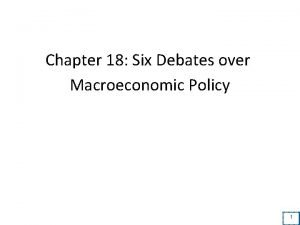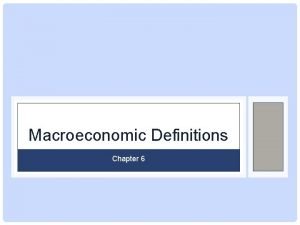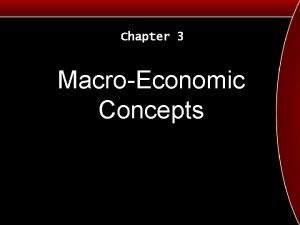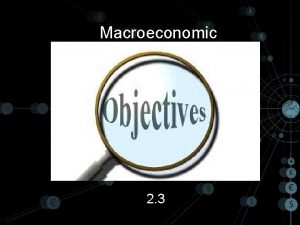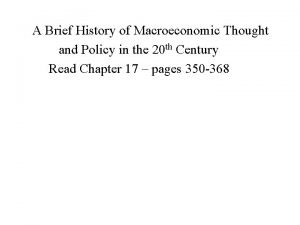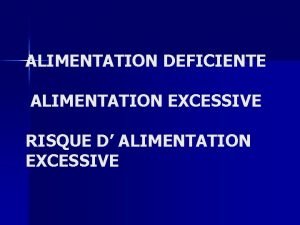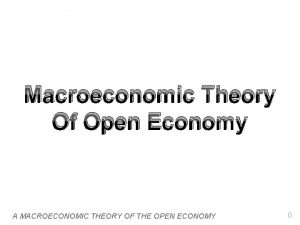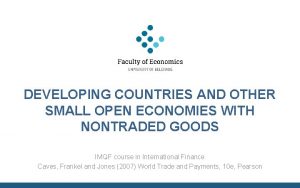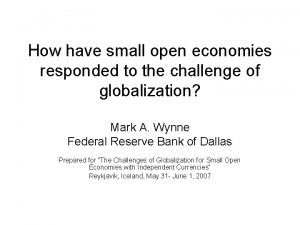Perspectives of the Small Open Economies Excessive macroeconomic










- Slides: 10

Perspectives of the Small Open Economies Excessive macroeconomic imbalances, financial instability and monetary policy in Croatia Dubravko Radošević, Ph. D Senior Fellow, The Institute of Economics Zagreb dradosevic@eizg. hr XXIV. International Scientific Conference Faculty of Economics and Business Zagreb & Economics Journal Room 14 (New Conference Room), Faculty of Economics and Business Bldg. , Zagreb, 25 th of October 2017

EU and economic policy coordination o Croatia was under European Semester framework immediatelly after entering European Union o Europen Commission launched two policy coordination initiatives: Excessive Deficit Procedure (EDP) and Macroenomic Imbalances Procedure (MIP), while Croatian National Bank became member of the ESCB

Main challenges ahead o Croatia exited from EDP in 2017, because fiscal deficit was reduced and public debt growth has been reversed, although at projected level of 84, 1 % it is still above the indicative treshold of 60 % of GDP o But, EC will continue with other monitoring tools within SGP and will continue with … o Macroeconomic Imbalances Procedure, because Croatia accumulated excessive macroeconomic imbalances (external imbalances are crucial) and Croatia has to achieve „real convergence”

Imbalances and their gravity o Private sector debt is about 120 % of GDP, and it remains heavily exposed to currency risks o In banking system there is a rapid accumulation of NPLs, and financial system remains exposed to the credit risk of its unhedged borrowers (unregulated shadow banking & Agrokor, are they Croatia’s Lehman Brothers? ) o High level of external debt (that moderatelly schrunk due to the deleveraging process) and a negative international investment position (NIIP) o Potential output growth remains low, due to the subdued productivity growth

Evolution, prospects and policy responses o The general government deficit is under control, while the debt-to-GDP ratio has moved onto the declining path, after tax reform (domestic payment arrears in public health sector? ) o Simoultaneous deleveraging of households, government and businesses is resulting in current account surpluses and the progressive reduction of external liabilities (but, external debt increase likely after default of Agrokor? ) o Uneployment has declined sharply, although mostly due to the shrinking labour force (employment is lower due to emigration, and well bellow EU targets) o Market inefficiencies still constrain potential growth (risks of „secular stagnation” in the medium term)

MIP Matrix and MIP Scorecard o MIP Matrix for Croatia 2017 indicates all the macroeconomic imbalances, gravity of challenge, evolution of imbalances and policy responses that are required to address imbalances o MIP Scorecard 2010 – 2015, and MIP Scorecard for 2017 indicates quantitative thresholds, aiming to indicate gravity and dynamics of the macroeconomic imbalances 2010 - 2017

Overall Assessment o o o The unwinding of debt related imbalances is accelerating on the basis of stronger economic growth, but vulnerabilities persist The financial sector is relativelly stable, but exposure to credit, currency and interest rate risks remains (negative spillover effects from Italy, in case of banking crisis? Target 2 & ECB? ) Progress with structural reforms has been limited (Country Specific Recommendations, CSRs? ) Euro adoption strategy for Croatia requires gradual and complex structural reforms; eurozone entry is impossible before Croatia successfully correct excessive macroeconomic imbalances and exit from MIP procedure and fiscal policy SGP monitoring Political (in)stability: new Coalition government (HDZ-HNSother) has a narrow margin in the Parliament

Conclusions o Structural reforms are lagging behind the schedule (National Reform Programme is not implemented) o Monetary policy is deflationary (NPLs, monetary transmision mechanism is not working, credit crunch, deleveraging of EU cross-border banks, persistent low inflation or deflation, real interest rates too high, unregulated shadow banking …) o Policymakers have only two options: (a) reflation (currency depreciation); or, (b) internal devaluation (wage deflation or fiscal devaluation); euroisation is possible in 2030? o Increased systemic risks in 2017 and 2018 (Agrokor collapse and banking crisis in Italy? )

Eurozone debt crisis o Joseph Stiglitz, Nobel-winning economist Stiglitz slams the euro in new book o https: //www. youtube. com/watch? v=Pf 32 Ch. NXb. Xs o Hans - Werner Sinn, „The Euro Trap: On Bursting Bubbles, Budgets, and Belief” o https: //www. youtube. com/watch? v=tm 6 REM-AFTg o Joseph Stiglitz, „The Euro” o https: //www. youtube. com/watch? v=ECo. W 1 nn. Trjo o Adair Turner, „Between Debt and the Devil: Money, Credit and Fixing Global Finance” o https: //www. youtube. com/watch? v=On. B 18 YHA 5 AU

Main references … o o European Commission, (2017): Country Report Croatia 2017 Including an In-Depth Review on the prevention and correction of macroeconomic imbalances; Brussels, 22. 2. 2017 European Commission, (2017): Debt Sustainability Monitor 2016; European Economy Institutional Paper 047; Brussels; January 2017 o o Radosevic, Dubravko and Vidakovic, Neven, (2015): Monetary Policy versus Structural Reforms: The Case of Croatia; Munich Personal Re. PEc Archive; MPRA Working Papers No. 63955; University of Munich; April 2015 Radosevic, Dubravko (2017): Euro Enlargement Between Convergence And (De)Financialization; Social Europe; 3 rd of October 2017; London https: //www. socialeurope. eu/e uro-enlargement-convergencedefinancialization
 A macroeconomic theory of the open economy
A macroeconomic theory of the open economy Open innovation open science open to the world
Open innovation open science open to the world Six debates over macroeconomic policy
Six debates over macroeconomic policy Macroeconomic definitions
Macroeconomic definitions Macroeconomics deals with:
Macroeconomics deals with: Five debates over macroeconomic policy
Five debates over macroeconomic policy Macroeconomic objectives
Macroeconomic objectives Macroeconomic and industry analysis
Macroeconomic and industry analysis History of macroeconomic thought
History of macroeconomic thought Five debates over macroeconomic policy
Five debates over macroeconomic policy Five debates over macroeconomic policy
Five debates over macroeconomic policy


